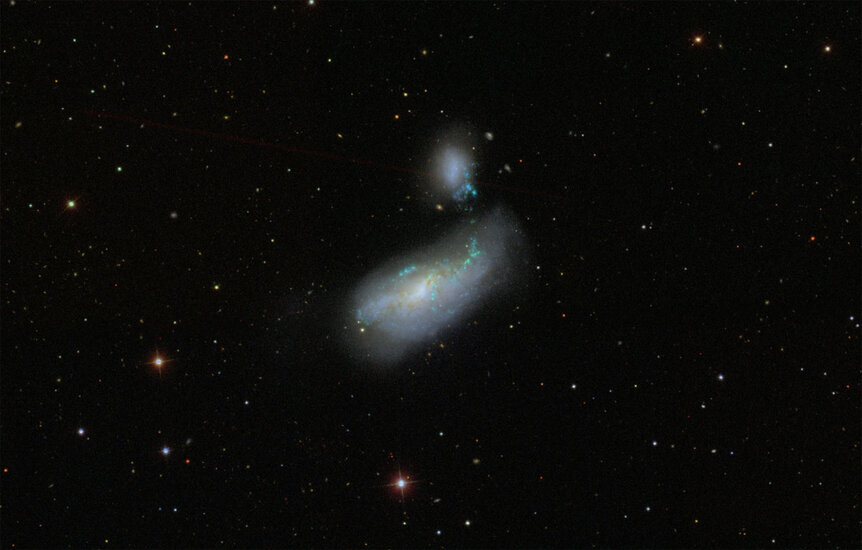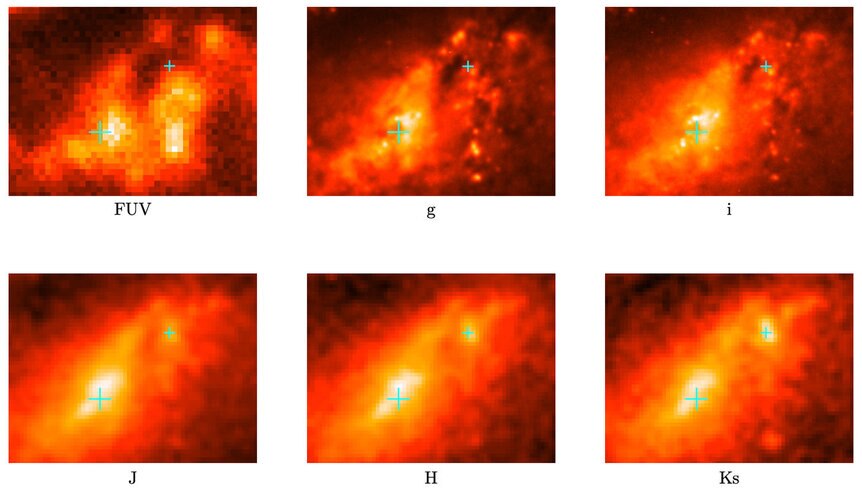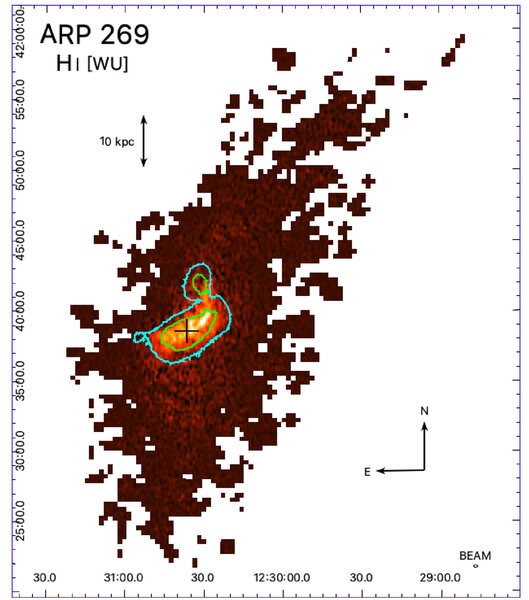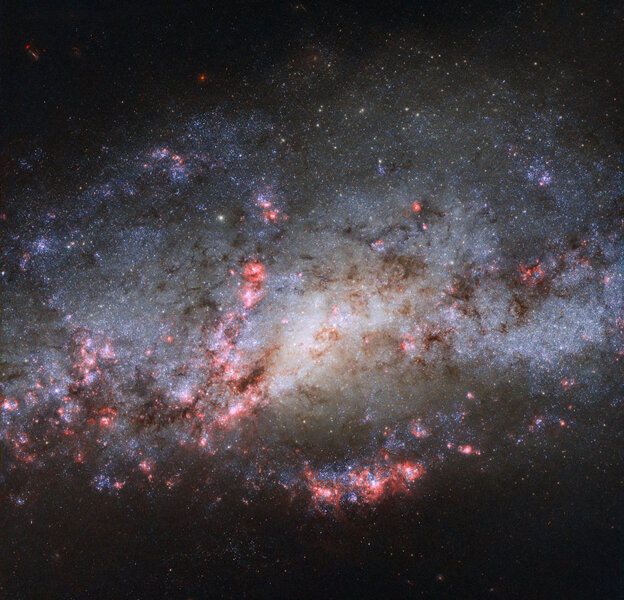Create a free profile to get unlimited access to exclusive videos, sweepstakes, and more!
Yo, I heard you like galaxy collisions so I put a galaxy collision in your galaxy collision
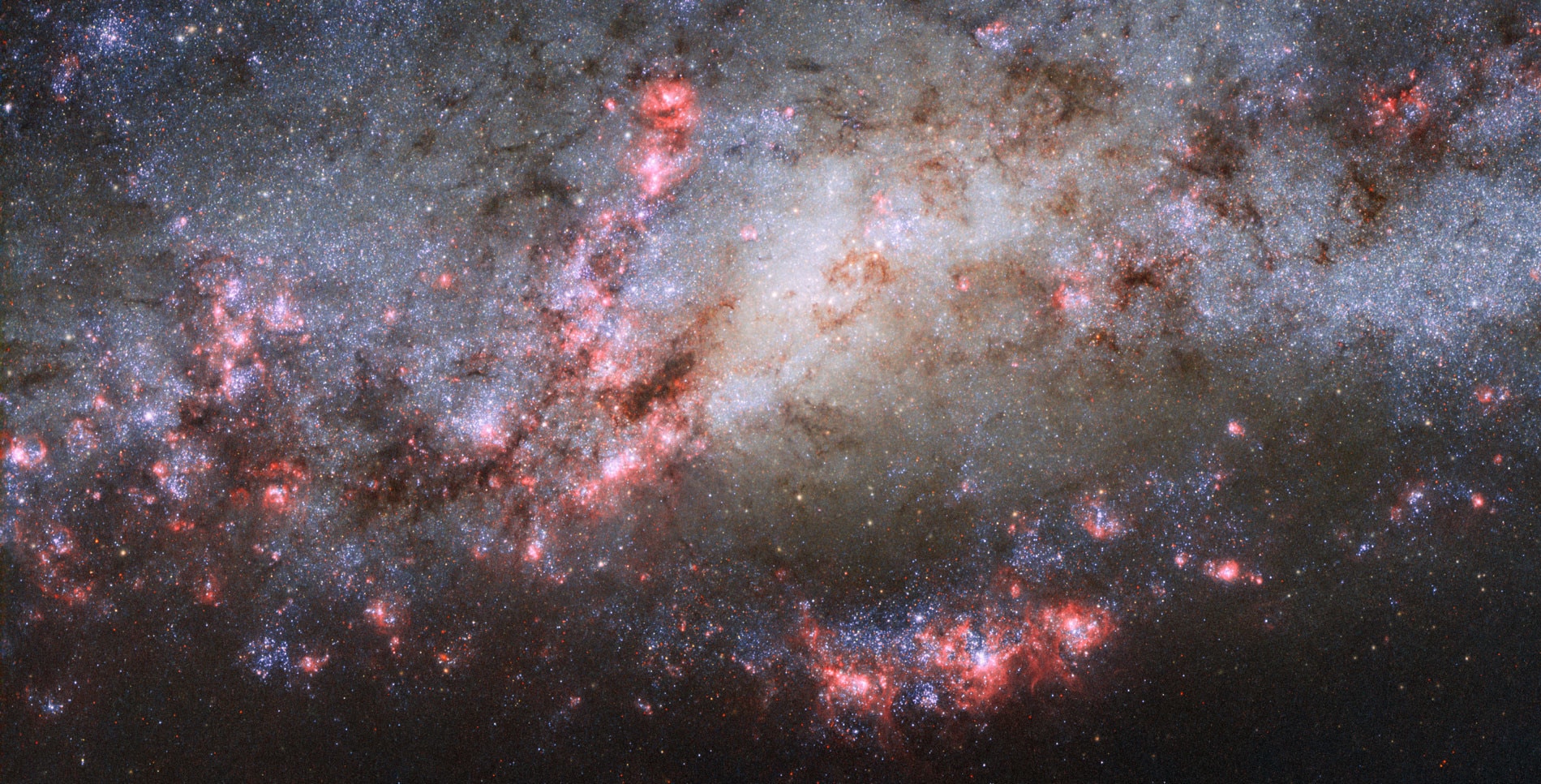
The galaxies NGC 4490 and NGC 4485 are caught in a lovers' embrace, a cosmic tryst that is all the more romantic because NGC 4490 apparently just got over a bad relationship, cannibalistically eating its previous lover.
Hmmm, maybe I pushed that anthropomorphized analogy a bit far. But the essence of it is correct: While these galaxies are in the process of colliding, one of them apparently already collided and merged with a galaxy a billion or three years ago!
The evidence comes from somewhat disparate observations of NGC 4490, the larger of the two galaxies, showing it has two nuclei. Usually, galaxies have a single nucleus, the central concentrated volume of stars in their cores. But a new paper by a team of astronomers show that NGC 4490 has two, and the most likely explanation is that we're seeing the late stages of a galactic merger*.
First though, the story behind the observations is pretty great. Allen Lawrence is a 77-year-old amateur astronomer who wanted to do some professional-level research. He took some astronomy classes at the University of Wisconsin-Madison and asked around for some independent work he could do. He wound up taking a look at NGC 4490, going through observations from observatories that see in different parts of the electromagnetic spectrum, from ultraviolet to microwaves.
What he found was remarkable: NGC 4490 has an obvious nucleus seen in visible light (the kind we see), but in infrared a second nucleus appears, distinct from the first. Apparently, the second one is enshrouded in thick dust, which blocks visible light but lets longer wavelength IR through. The weird thing is that no one seems to have noticed this before! Lawrence thinks that different astronomers looked in different kinds of light, but "never compared notes". It wasn't until one person reviewed all the data that it became obvious.
Lawrence and his group examined the two nuclei and found they are remarkably similar. Each has roughly the equivalent of a billion times the Sun's mass worth of stars (which equates to more than a billion stars, since most stars have a mass less than the Sun's), both are about the same physical size (about 3,000 light years wide), have about the same luminosity (intrinsic brightness), and even have the same rough shape. If the second nucleus weren't buried in dust, it would've been discovered decades ago.
When galaxies collide, they usually pass each other once or twice, dipping together then pulling apart again, before finally merging. That makes a hash of the structure, of course, but eventually it settles down. The nucleus of the smaller galaxy falls down toward the center of the bigger one, and eventually merges with it as well… but this whole process takes from 1 – 3 billion years. It looks like we're seeing the very last bit of the dance.
If that's the case, it does clear up a mystery. NGC 4490 sits in the center of an enormous cloud of neutral hydrogen (called HI), seen in radio wavelengths. This plume is elongated north/south, and is nearly a half million light years long! But how did it get there?
Before, it was thought that perhaps it was blown out due to NGC 4490 and NGC 4485 colliding with each other. Collisions like this tend to slam gas clouds together, which can trigger a lot of star birth. The massive stars born are very luminous, and blow strong winds of subatomic particles (like the Sun's solar wind, but far more powerful). Their combined wind would blow neutral hydrogen out of the galaxy, creating the huge plume. As it happens, NGC 4490 is currently making stars at a rate five times what the Milky Way does.
However, the timing for the plume creation doesn't really fit, and there are other problems with this idea as well. But now it makes more sense: The plume was probably created in the previous merger, the one where NGC 4490 ate the galaxy that had the other nucleus. That merger made lots of stars, which then blew out the plume. Or, it's also possible the plume may have formed due to the merger itself. During the collision, the galaxies' mutual gravity can pull out long streamers of gas and stars, flinging them out of the galaxies. This is called a tidal tail, and it's common in mergers. It's not clear which might be the cause, but the previous merger was likely the trigger one way or another.
So that's pretty nifty. This is all also a good lesson — two, in fact. One is that it can be impossible to understand what's going with an astronomical object when you only observe it in one wavelength. Had we stuck with visible light images the second nucleus wouldn't have been found (or vice-versa for infrared observations). The more different ways you observe something, the more complete a picture you build up.
But it also stresses the importance of teamwork in science. Somehow, this second nucleus got missed by people who have observed these galaxies, despite it being obvious enough once different wavelengths are compared. The media loves the idea of a "lone scientist" making discoveries in his (and it's always "his" for some reason) lab, but in reality science these days is a collaborative effort. Sure, Lawrence found this second nucleus, but he did so by looking at many previous astronomers' work. And even then he was one member of a team analyzing the data.
And an ironic mea culpa: I wrote about these galaxies in 2019, describing a Hubble image of NGC 4490; I deduced there must be a second galaxy affecting it, and sure enough when I looked for a wider-field image NGC 4485 came into view.
But what I had totally forgotten is that I had written about both of these galaxies just the year before! I usually check my archive before writing an article on an object to make sure I haven't covered it in the past, but I must have neglected to do that when I wrote the second article. So, ironically, I should've checked my own work to see what I already knew about the galaxies before writing it.
I guess there are lots of lessons here. But a good one, I think, is that it's never too late to start doing something you love. It may not always pay off, but it'll be fun, and you never know. Cosmic rewards may await.
*The authors also looked at the possibility it might just be a giant gas cloud busily forming stars. However, it would have to be hugely larger than other regions in the galaxy, including a couple nearby the second nucleus, which seems unlikely. Also, its profile matches that of the first nucleus so well it seems that it being an actual nucleus is the more likely explanation.
